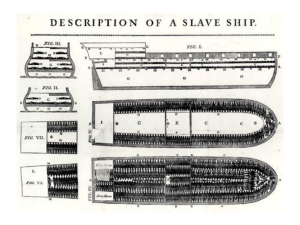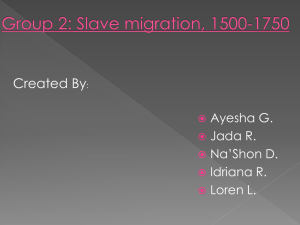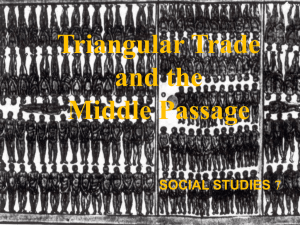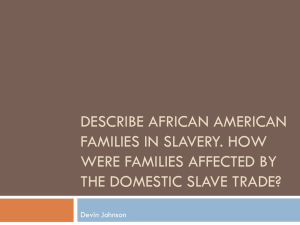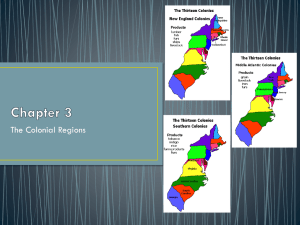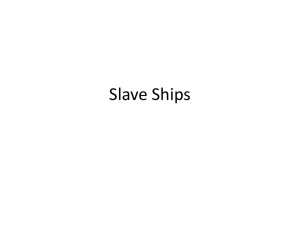Beginning African-American Genealogy 2007 version
advertisement
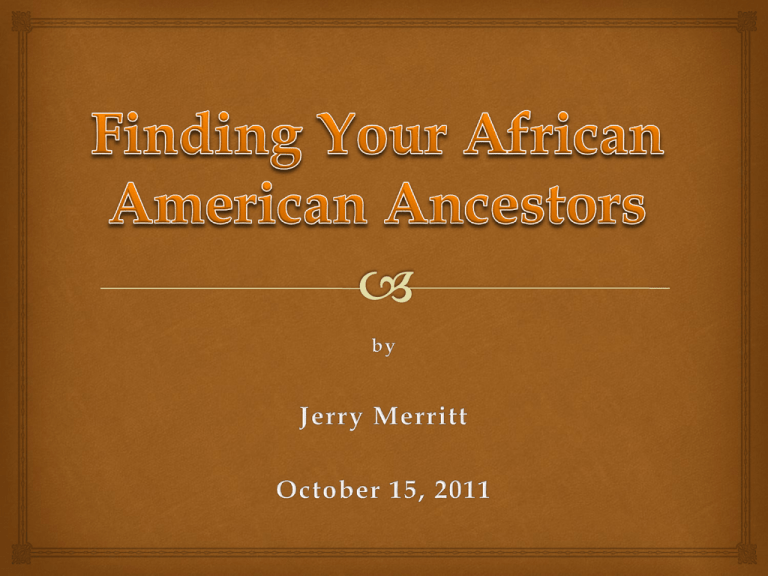
Suggest resources to get you started. Show how to interpret the data you find to speed you along in your search. Present some successful examples of AA reseach. Why Do Genealogy? To Recover and Preserve your past. A family’s history can vanish in one generation. It’s a legacy you leave your descendants. It’s a tribute to your ancestors. It’s interesting, surprising, and fun. You’ll meet a lot of 2nd and 3rd cousins you never heard of. It gives you a family medical history. It’s your own personal puzzle left to you by Fate. So. Are you ready for a challenge? How Do You Get Started? You need a map. The Pedigree Chart. So, how do you find the information for the Chart? Resources Family members – especially elders. Family Reunions are full of old folks with stories. Old Family Bibles often have a filled-in Pedigree Page. Old photographs often have names on the back. WWI and WWII Draft Cards Social Security Records Birth Certificates Death Certificates Church Records Census Data Cemeteries Internet DNA How Far Back Can You Go? It should be easy to trace back to 1870 – or 140 years. If you count 25 years to a generation, that’s 5 generations. If you go that far, you will have found 62 ancestors. And some of your lines will trace back farther because you will often find great-great-greatgrandparents living with their parents. With a little luck and some detective work you can get back much farther than 1870. Free People of Color While most Africans in early America were slaves, many had been freed by the time of the American Revolution. Your chances of having one or more of these freed people somewhere in your linage is fairly significant. That makes it easier to trace them with pre-1870 census data. Here’s a “for instance.” Excerpt from 1790 Maryland Census Excerpt from 1790 Charleston, SC Census Starting The Family Tree Begin with yourself and work into the past. Finding your grandparents in the census is an excellent start. The Census In the old days we used microfilm copies. Today we go to the Internet. There are several excellent sources to research census data. And all of them are readily available for free. And you can use them from your home computer. Census Takers Many censuses were taken in a rather haphazard manner. So… Don’t believe everything you see on a census. Look at several before drawing any conclusions Don’t think the names are going to be spelled then the way you spell them today. Don’t think the names will be spelled the same from one census to the next. Now we’re ready to trace some families Let’s take a look at a census. Here’s one from 1920 Molino, FL. James Williams A closer look Dropping back to 1910 Pulling up a Death Certificate Name: James Williams Death Date: 01 Mar 1931 Death Place: Cedar Town, Escambia, Florida Gender: Male Race (Original): C Race (Expanded): Colored Death Age: 75y Birth Date: 05 Apr 1855 Birthplace: Ala. Marital Status: Married Spouse's Name: Katie Williams Father's Name: Jim Williams Father's Birthplace: Dk Mother's Name: Pollie Mother's Birthplace: Dk Occupation: Laborer Place of Residence: Cedar Town Burial Place: Cedar Town Burial Date: 03 Mar 1931 1935 Florida Census Molino, Escambia Co. So much for tracing forward in time. Let’s go find another family and trace them back into the 1800s. 1900 Molino, FL Escambia County Marriage Records 1821 to 1900 Gilbert Bird to Maria Bird License date Sept. 18, 1871 Book G – Page 125 Gilbert Bird to Maria Bird License date Sept. 18, 1871 Let’s consider this marriage info for a moment. There are some very important clues in here. Why are they both named Bird? And didn’t they say in 1900 they had been married 52 years? That would have them married in 1848 – not 1871. Here is that 1900 census data again Now we have a bit of a Mystery. So what do we do now? We’ll just have to get more data. 1885 Escambia Census The Byrd Family in 1885 State Census Byrd Byrd Byrd Byrd Byrd Gilbert Maria Gilbert Vergie Angella B B B B B 56 50 23 Son 7 10 VA NC FL FL FL VA NC VA NC Byrd Henry B 29 FL VA NC Byrd Byrd Ann Maria B B 22 5 AL FL AL AL Saw Filer Laborer Let’s go back even farther 1884 1883 1882 1881 1880 1880 Molino, FL So, is Nellie Mariah’s mother or Gilbert’s mother? Or is she a sister to one of them? Notice that both Mariah and Nellie are born in NC. Also note Nellie has a granddaughter, Annie, with her. And, Annie was born in AL in 1859 and has a daughter named Mariah whose mother was born in FL. Wait. What? Annie was born in AL and her “daughter’s” mom in FL? All of the kids Mariah (elder) has with her were born in FL. Annie is married – not widowed – but Mariah’s sons are single. Did anyone notice that Nellie’s family were all Mulatto? Early Race Indicators Censuses use: W for White I for Indian B for Black and M or Mu for Mulatto. Marriage Records often use C for Colored even back into the early 1800s. B vs. M or Mu Watch for M or Mu in the Race Column. If you see M or Mu, even if only once out of several censuses, it probably means the person was Mulatto. This term is little used today because of connotations to slavery and oppression. Mulatto, however, existed as an official census category until 1930. B vs. M or Mu Mulatto denotes a person with one white parent and one black parent, or more broadly, a person of mixed black and white ancestry. The other partner could be White, Indian, Hispanic, Mulatto, Melungeon, Asian or Creole depending on the part of the country and the time period. View it as another clue that may help solve a link. And it may be, as we shall see shortly, a powerful clue. Or it may be merely an indication of light complexion. What’s it all mean? The 1880 Byrd data looked promising at first glance. But what are all those 1880 clues trying to tell us? It just looks like a mess. Well, let’s compare that 1880 census with the 1885 census. Here’s 1885 vs 1880 Byrd Henry In the 1885 Byrd Byrd Ann Maria B census we29had B B And in 1880 we had 22 5 FL VA NC AL FL AL AL Back to 1885 again Byrd Gilbert B 56 Saw Filer VA VA VA Byrd Maria B 50 NC NC NC Byrd Gilbert B 23Son Laborer Fla Byrd Vergie B 7 Fla Byrd Angella B 10 Fla So, what does this mean? Nellie must be the elder Mariah’s mother. Since Annie is listed as the granddaughter of Nellie in 1880 and is married to Henry Byrd in 1885. we might reason that she was really the granddaughter-in-law. Because little Mariah/Maria is also Henry’s daughter and the great-granddaughter of Nellie. Henry must be Nellie’s grandson so…. Using 2 censuses we solved the confusion and picked up 4 generations. Here’s a Review Nellie – born in NC as was Mariah’s mother Gilbert and Mariah – Henry’s parents Henry who married Ann – Nellie’s grandson Little Mariah – great-granddaughter of Nellie and daughter of Henry This also shows that Mariah really was a Byrd before she married Gilbert Byrd. BUT Are we really sure that in 1880 the Annie with Nellie was the same Ann married to Henry Byrd in 1885? After all, the 1880 census said Henry was Single. Maybe Annie was married to another of Nellie’s grandsons. And Henry just happened to marry an Ann and had a daughter named Maria / Mariah by 1885. How can we tell which is the true story? Checking Henry’s Marriage Henry Bird “C “ to Annie Horton “C” on 18 Apr 1878 H. Welch, Minister -- Allen Chapel A. M. E. Church Book J – Page 15 So the Annie listed as Nellie’s granddaughter in 1880 was, in fact, Henry’s wife. Plus we pick up data on their church. And find out Annie’s maiden name. So, where were the Byrds in 1870? 1870 Molino, FL 8. Born: Wed: Died: 9. Born: Died: Combining Clues 2. Henry Byrd Born: 1856 Place: Florida Wed: 1878 Place: Escambia County, FL Died: Place: 4. Gilbert Byrd Born: 1835 Place: Virginia Wed: Place: Died: Place: 10.Byrd Born: Wed: Mariah Byrd If there’s a lesson with the 5.Byrds, it’s this: Born: 1835 Died: Don’t look at clues in isolation. Place: North Carolina 11. Nellie Died: Born: 1820 North Carolina 1. Mariah Byrd That 1880 census alone couldn’t Place: explain theDied: Born: 1879 Place: Florida relationships. 12. Moses Wed: Born:Horton is not Place: 6. Moses census Horton Wed: four But added clues from the 1885 clarified Annie Horton’s Died: Born: 1838 Died: Place: Place: Georgia 13. father. generations of relationships. Wed: Born: 3. Annie Horton into context Place: with other clues. Died: So, put each clue LEGEND Born: 1856 Died: 1. You Place: Alabama Place: 14. Two or three clues combined can give you ten 2. Your Father Died: Born: times 3. Your Mother Place: 7. Nancy Wed: more information than each individual clue taken 4. Father’s Father Born: 1840 Died: 5. Father’s Mother Place:Florida 15. alone. 6. Mother’s Father Died: Born: 7. Mother’s Mother Place: Died: Annie Byrd Name: Annie Bird Death: 17 Mar 1918 in Molino, Florida Gender: Female Race: Black Death Age: 52y Estimated Birth Year: 1866 Birthplace: Pine Apple, Ala. Father's Name: Andrew Ford Father's Birthplace: Ala. Mother's Name: Nancy Horton Mother's Birthplace: Ala. Occupation: House Work Burial Place: Molino, Fla. Collection: Florida Deaths, 1877-1939 Many of the courthouses in the South were burnt. Those ancestors who were slaves won’t appear in a census by name when they were slaves. Going back to the Byrds Gilbert, Mariah and Nellie were all Byrds. What’s the chance of two Byrd Families marrying? There’s a better explanation. Freed slaves usually had no last names. Many adopted the last names of their former owners. So it would be worth checking slave records of slave owning Byrds in NC. Because the surname data suggest that at one time Gilbert, Mariah & Nellie all lived on a Byrd plantation. Switching Gears Up to now we have been tracing names. And we have good info on the Byrd family. This info will now come into play in a different way. When you get back to slave schedules you have to look for whole families – not individuals. Here’s why. Federal Slave Schedules Calling up slave data. In 1850 and 1860 slaves were listed on separate census schedules. In 1790, 1800, 1810, 1820, 1830 & 1840 slaves were included with the family. So, what does a slave schedule look like? Comparing 1860 Ages Nellie 40 Gilbert 28 Mariah 25 Cornelia 6 Henry 4 Well…. I didn’t find a fit for the Byrds in any of the NC slave schedules. That’s a surprise. What am I missing? Let’s go look at that 1880 census again. Ah Ha! I should have been looking in Florida – not North Carolina. Slave Owner W C Bird Jefferson, FL Nellie 40 Gilbert 28 Mariah 25 Cornelia 6 Henry 4 Slave Information Age Gender Race 70 Female Black 70 Male Black 42 Male Black 40 Male Black 38 Female Black 35 Male Black 27 Male Black 25 Female Black 23 Male Black 19 Male Black 17 Female Black 16 Male Black 16 Female Black 14 Male Black 11 Female Black 10 Male Black 9 Female Black 7 Male Black 6 Female Black 5 Male Black 5 Male Black 3 Male Black 1 Male Black Nellie It is not very satisfying to have to use the 38 year old black female in the 1860 slave schedule as Nellie. She should be 40 years old in 1860 And she should be Mulatto. So, let’s keep gathering data. W. C. Bird In 1860 he is 22, in Jefferson County, FL and quite well-to-do with real estate of $7,400 and personal property of $1,400. He was born in Florida. His full name was William Capers Bird. More researching quickly turns up his father. Daniel Butler Bird William’s father was Daniel Butler Bird 1788-1865 In the 1860 slave schedule of Jefferson County, FL Daniel had a 40 year old Mulatto female. We just found Nellie! IMPORTANT NOTICE At his point we don’t know for sure that we have found Nellie and her family. All we have done is found a slave schedule where they fit. There were no names on those slave records. We have merely found a good clue about where to go to check courthouse records. It will take the courthouse records that prove or disprove this link. We’ll look at some courthouse records in a minute. Okay, back to the chase What’s next on the Byrds? After all, we don’t have any slaves’ names from the slave schedules. Review I ruled out the Byrd/Bird slaveholders in NC. I had the good luck to find only one Bird family in FL that held slaves that matched Gilbert’s family. That left me with only one location to go research. Frequently, one family will be a near-perfect fit. But if you can’t find a fit, move on. Perhaps they didn’t take on the slave owner’s name. And let’s take one last look around for clues before we move on. A Clue from a Church From the Pensacola Journal 1908 Also – in 1870 Miss. Another clue??? Gilbert Bird’s DC Name: Gilburt Burd Death Date: 13 Dec 1925, Molino, Fla. Race (Original): Negro Death Age: 70y Birth Date: About 1855 Birthplace: Bagdad, Fla. Marital Status: Widowed Spouse's Name: Father's Name: Gilburd Burd Father's Birth: So. Carolina Mother's Name: Maria Mother's Birth: Florida Occupation: Mill Laborer Burial Place: Molino Slave Trading was Big Business. And it required good record keeping. So we go to the Courthouse…. For Slave Records which often mention parents’ names. For Wills which often list slaves by name and age. For ship manifests after 1808. Slave Sale Records Extracted from South Carolina records: Record: 202 of 272 records Series: S213003 Volume - 003P Page - 00495 Item - 00 Date: 1801/10/13 Description: DOUGLASS, NATHANIEL TO GEORGE POWERS, BILL OF SALE FOR A SLAVE NAMED PATIENCE. Record: 210 of 272 records Series: S213003 Volume - 003T Page - 00559 Item - 00 Date: 1805/03/29 Description: DOUGLAS, JOHN TO ROBERT VERREE, BILL OF SALE FOR A SLAVE NAMED EDY AND HER SON NAMED GEORGE. Record: 287 of 379 records Series: S213003 Volume - 004F Page - 00449 Item - 00 Date: 1813/10/15 Description: CHANLATTE, HARRIETTE CAMEAN TO ADEL POINTIS AND LAFINE CLEMENT, BILL OF SALE FOR A SLAVE NAMED CHARLOTTE, ABOUT 18 OR 19 YEARS OF AGE. Record: 227 of 272 records Series: S213003 Volume - 004I Page - 00400 Item - 00 Date: 1815/05/31 Description: DOUGLAS, JAMES TO JOHN WHITING, BILL OF SALE FOR A MALE SLAVE NAMED SANDY. Record: 229 of 272 records Series: S213003 Volume - 004I Page - 00432 Item - 00 Date: 1815/07/05 Description: DOUGLAS, JAMES, ATTY. FOR PATRICK MCDERMOT, ADMOR. OF THOMAS LYNCH TO SAMUEL CROMWELL, BILL OF SALE FOR A SLAVE NAMED POLLIDORE. Record: 230 of 272 records Series: S213003 Volume - 004I Page - 00435 Item - 00 Date: 1815/07/08 Description: KIRKPATRICK AND DOUGLAS TO DUNCAN LEITCH, BILL OF SALE FOR A SLAVE NAMED JACK, ABOUT 29 YEARS OLD. Extract from the Will of Anthony M. Minter Dallas County Alabama …I give to my Daughters Louisa King Wife of Peyton King and Elizabeth Mitchell the Widow of A.J.D. Mitchell Decd, That is to say Man with a Woman and her six Children named as Collins, Charles, [Crachs?], Edward, Malinda, Duke, William, Celia and her two children Jordan and James a Woman named Mary, a woman named Lucy, a Woman named Mariah, a Woman named Maria Lucy, a Woman named Mariah, a Woman named Charlette - Wester a man, Isaach a man, Toney a man, Jocef a boy, Little Wash a boy, Littleton a man, Martha a Woman, Martin a man, John a boy, Nelson a small boy, Moses a man and Isham a man…. The Beginning of the End of Slavery In Article 1, Section 9, of the Constitution Congress was limited, expressly, from prohibiting the "Importation" of slaves, before 1808. Congress, however, passed a law that became effective on January 1, 1808. That law prohibited the importation of slaves into the United States A Million Slaves Sold South Eli Whitney’s cotton gin (1793) was inexpensive enough for plantation owners in the South to purchase. This greatly increased the demand for & value of slaves. Virginia and Maryland had slaves for their tobacco fields, but could make money selling their slaves south. Over 1 million slaves were sold into the Deep South 1820, Congress passed a stronger law to enforce the illegal importation of slaves from Africa making participation an act of piracy punishable by death. This led to exquisite record keeping by ship captains. This bit of history works greatly in favor of the African-American researcher. Keep those dates (1808 and 1820) in mind as you search for records. Now – an example record. 7 Dec 1840 Ship Manifest From Virginia To New Orleans Isabella Sanders John C. Weldon Prince William County Virginia To G. G. Noel New Orleans And these are only a few of the records available. After researching numerous court records you will eventually arrive back at the debarkation of a slave ship. This leads to…. DNA “We don't have to just say that we are from Africa anymore, we can say 'I'm from Sierra Leone,' or 'I'm from Cameroon.'" Dr. Rick Kittles Tracing back to your Ancestral Village in Africa As impossible as it may seem, modern DNA techniques can track Y DNA and mDNA back hundreds of years. There is at least one company that does that. It is a Washington D.C. company run by Dr. Rick Kittles http://www.africanancestry.com/ Paternal & Maternal Lines A Final Angle to Consider What About Mixed Blood? “About 30% of black Americans who take DNA tests to determine their African lineage prove to be descended from Europeans on their father's side.” Dr. Rick Kittles Scientific Director of African Ancestry Another 2% carry Amerindian genes. How Does That Affect DNA Testing? If you have a European male ancestor on your paternal line - even twenty generations back – your lineage will show up as European even though all your other ancestors are of African heritage. It can be very misleading. Do the hard stuff first. Then use DNA to help sort out problems making connections. So, back to the hard stuff…. Three Places to Start Heritage Quest Family Search Ancestry $ But Ancestry is FREE… Right out there in the library. How is AA Census Research Different? Ultimately, the difference is in how slaves were enumerated. From 1870 forward there is no difference. From 1850 to 1860 you use Slave Schedules vs. Censuses. And you have no slaves’ names. But this period is just like pre-1850 census research. Except the slave data is an order of magnitude better. Before 1850 the slave research is not significantly different. No one before 1850 was named except the Head of Household. And everyone had only an age bracket. Slaves included. It all evens out 1860 1850 1840 1830 All Names Only Head o Slave Owner Name o 1930 1920 1910 1900 1890 1880 1870 1860 1850 1840 1830 1820 1810 1800 1790 All Names Non-slave All Household Names on Census Only Head of Household Name on Census Slave Owner Slave 1860 1850 1840 1830 1820 1810 All Names Only Head of Household Here you have a problem finding the slave owner’s Slave Owner Name on Census name. Here you have a problem finding the wife’s father’s name. But, while the problem of slaves not being named on the slave schedules lasts 20 years past 1850, the slave records are more comprehensive. So, for women, children and slaves before 1850 the censuses don’t list their names. For slaves in 1850 and 1860 the slave schedules still don’t list their names. This lack of names is a big problem for everyone when working backwards through the census data to match a person to a head of household or slave owner. Now, back to matching former slaves to a slave owner or, prior to 1850, a head of household. The Transition Problem It comes at the transition from Slave to Free. Whether after the Civil War. Or earlier for Freedmen. And it’s a Bear. There are many ways. Here are a few. One way is the way we have covered in the example of the Byrds. Assume the family took the slave owner’s name. This is probably the second easiest way. Contracts A more difficult way is to locate sharecropper contracts in the county where your family was listed in the 1870 census. Because most freed slaves were poor, illiterate and fearful of the wide-spread violence after the war, they often stayed on the plantation for several years. They would contract for a particular section of land to farm and agreed to let the owner sell what they raised and give them half the profits. Propinquity Yet another way is to look at White families listed near them in the 1870 census. Since they may not have yet moved off of the old plantation they might be listed close to the former slave owner on the census. I have seen former slaves living with the former owner in the 1870 census. The Easiest Way Find family lore passed down from generation to generation. I have run across several beginning AfricanAmerican researchers who already knew the last slave owner’s name. They got it from elders or reunions or 2nd cousins or where ever. Family lore is usually quite accurate. At some point, however, you have to use courthouse records to verify you actually got the final slave owner right. You have to do the same to match unnamed wives and children to a named head of household as well. And you use some of the same records – wills, contracts, etc. – but you also use slave records to match former slaves to a particular household. Other Differences in AA Research Early Free People of Color often had only first names. Large groups of families with the same last name may all be from the same slave owner and are unrelated. It’s not unheard of for a male to change his last name one or more times between 1870 and 1920. Having two race categories, B and Mu, often greatly assists research. That’s about it Just remember when you get discouraged…. It’s written down somewhere. You just have to find it. 1. 2. 3. 4. 5. 6. 7. 8. 9. 10. 11. 12. Collect family knowledge. Locate grandparents in censuses. Track grandparents back to their parents. Keep tracking generations as far back as possible – usually 1870. Access all of the data you have collected. Make educated guess about state and county of last slave status – with slave holder’s name, if possible. Match family to slave schedules in that county. If you can’t find a match, go back to step 5. Go to courthouse records for slaves’ names & parents. Research slave holder’s family to see where they came from. Keep going back following wills and slave sales adding generations as you go. Debarkation from a slave ship marks end of research in US. Talk to all your family members to see what they know. Begin to complete your ancestry chart. Learn to use all the various resources available. Don’t depend on one site, like Ancestry, for all data. Search using all potential variations in a name. When you get back into slave schedules, search for families not individuals. Visit courthouses in the areas where your ancestors lived. Attend WFGS to learn of new sites as they come on line. Never give up.
